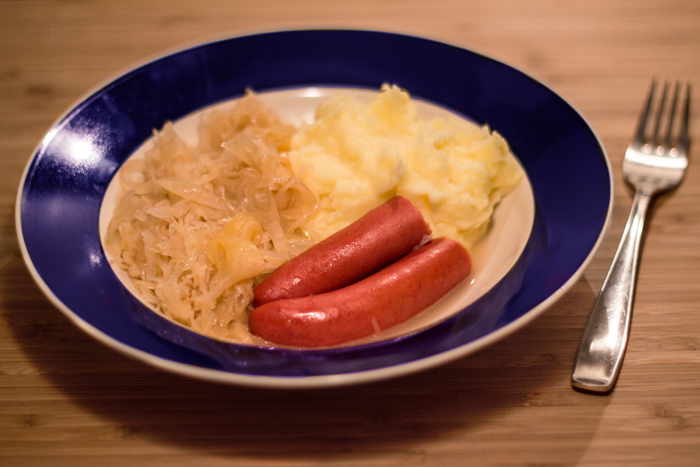
There are few things that invoke the thoughts about German food like mentioning sauerkraut. It literally translates to “sour cabbage”, which I’m sure is already causing some folks to make a face. I feel like sometimes it gets a bad wrap. Trust me when I say that German sauerkraut is not supposed to taste like what you get on your Reuben sandwiches or from the hot dog vendor. There’s nothing necessarily wrong with that flavour, it’s just different and usually crunchier. Warm sauerkraut shouldn’t really crunch.
Jump to the making of the Bavarian Style Sauerkraut!
Within my immediate family, when we say we’re making sauerkraut, what we actually mean is we’re making a meal that consists of this Bavarian style sauerkraut, mashed potatoes with German sausages or some pork. What I’m going to highlight with this post is how to doctor up the sauerkraut so that it tastes more like what you’d get in Germany. If you don’t like the sauerkraut you’ve had stateside, I’d almost be willing to bet you’ll like it this way. I say almost because I’m not a betting girl when it comes to trying to get people to try new flavours. I’ve know too many people that are extremely picky about food (myself included when I was little).
I feel like I must warn you that this is a very “yellow” meal, which isn’t that easy to make look appetizing through pictures. But I promise you, it’s darn tasty.
A Little Bit of History
Despite what most people think, sauerkraut wasn’t invent by the Germans. According to Wikipedia, folks have been pickling cabbage with salt since the Roman times. It is believed that the Chinese were fermenting cabbage with rice wine over 2,000 years ago and it was later brought over to Europe by a Mr. Ghenghis Khan. It became extremely popular in Germany and Eastern Europe. Also, seagoing men, like Captain James Cook, were all about sauerkraut because it kept away scurvy.
The Healthy Kraut
Did you know that sauerkraut is said to be really quite good for you? It’s low in calories, high in vitamin C, B, K, calcium and magnesium. It’s also a great source of dietary fiber and iron. If you eat it raw, it’s full of wonderful probiotics and enzymes that are ever so good for your digestive tract. My mother has always touted that drinking the juice as a great way to keep your kidneys clean.
Still, keep in mind that it’s pretty high in sodium because it’s pickled with salt.
Zum Wohl! (To your health!)
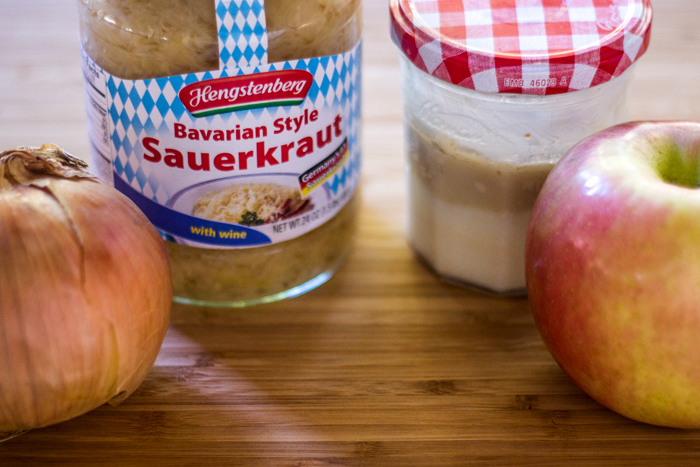
This is all that’s required for making a simple Bavarian sauerkraut – A jar of sauerkraut (preferably with white wine), a medium to large yellow onion, an apple and some bacon fat.
Yes, I specifically keep a jar of bacon fat in my fridge just for this purpose. You don’t have to use bacon fat, but I think as most meat eaters will agree, bacon is delicious (apologies since that might be a little over used but’s still true). I have used olive oil in lieu of the grease when making it for a vegetarian friend of mine and it worked great. If you wanted the thicker consistency (and weren’t being fat conscious) of bacon fat, you could also use a vegetable shortening, like Crisco.
You might be wondering why add all this extra stuff to the sauerkraut? Trust me. It makes a HUGE difference in the taste. Don’t like the “sour” in sauerkraut? This will knock most of that right out.
I’m also guessing that some of you are wondering where the heck you’re going to find that brand of sauerkraut. The Hengstenberg brand is quite popular in Southern Germany and incredibly easy to find in the Seattle area at the local German delicatessens or World Market. It’s my favourite brand (and the best tasting in my humble opinion) but it certainly isn’t the only kind. If you want to make the effort, check your local European food store or anywhere they sell more cultural foods. Look for one with white wine, if you can. Though, honestly, you should be able to use any jar of sauerkraut for this recipe and just add a cup of dry (or semi-sweet) wine white to get a similar result. Just try to stay away from the canned stuff, okay? Okay.
In the future, I plan on experimenting with some popular, American brands (like Claussen) to compare it to Hengstenberg. I’ll be sure to let you know the results.
Okay, on to the Bavarian style sauerkraut cooking!
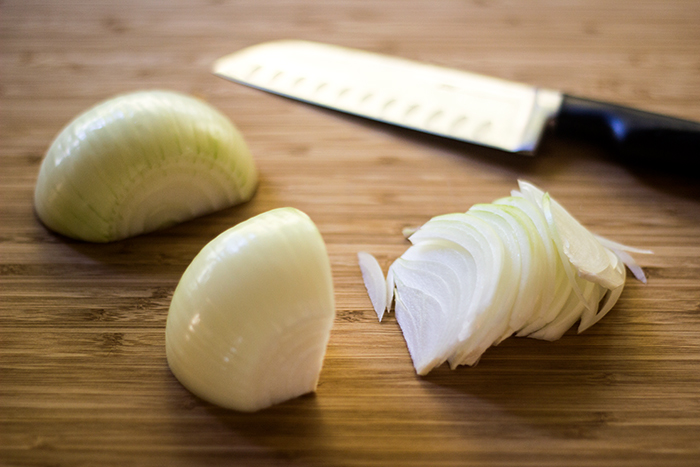
First, we thinly slice the onions. I’m not a super pro at this like my Dad yet but I’m working on it. Whether you slice the onion in rings, halves or vertically, like I am, doesn’t really matter. Just about making them as thin as you can. Think about making the onion slices mimic the strands of cabbage in the sauerkraut.
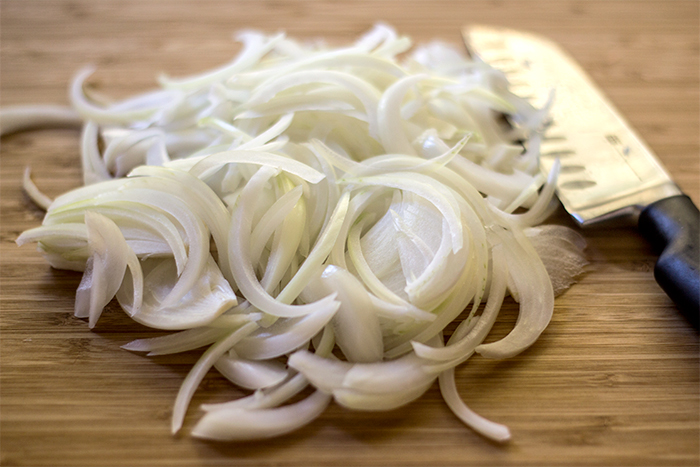
All sliced and ready to be set aside for now.
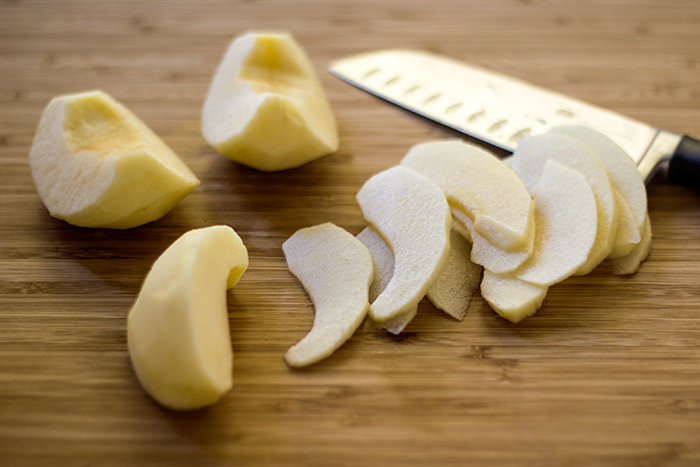
Now, let’s peel, core and thinly slice that apple as well. This will help the apple meld nicely into the sauerkraut to the point where it will be barely noticeable other than the fact it has imparted a great deal of sweet flavour. The type of apple you use isn’t that important. I’ve always used Fujis because they are a family favourite. However, just look for something that’s more sweet than tart.
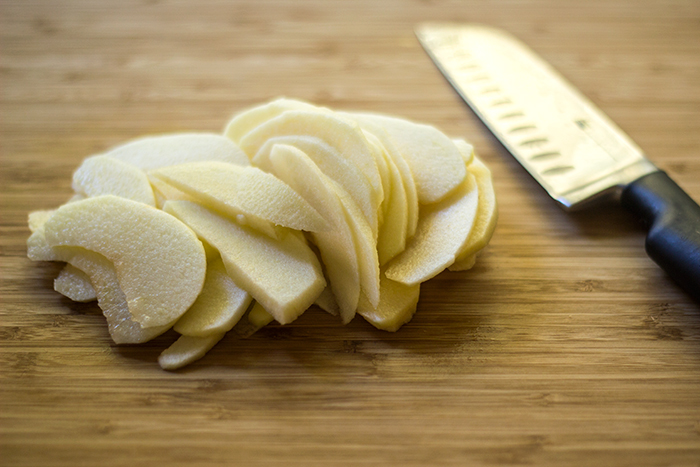
There we go! Ready to be aside for now. (Yes, yes, I know! Still working on my constancy and knife skills. Gordon Ramsey would have kicked me out of the kitchen by now.)
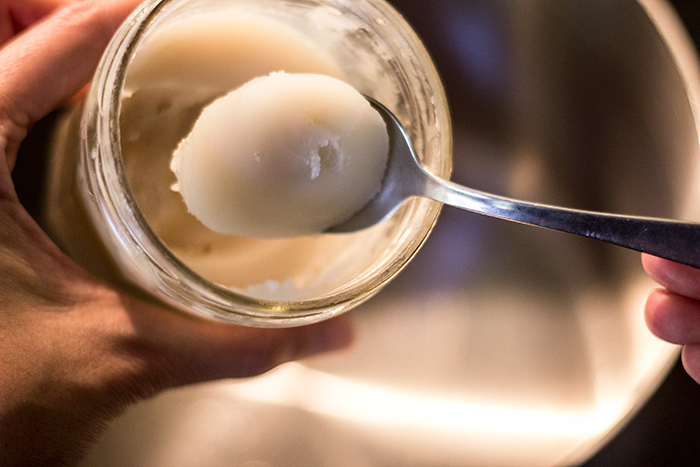
Okay, so this is where I can’t give you an exact measurement because I never measure. Just take spoonful of bacon fat and melt it in a large pot over medium heat. I usually use my big, 5 quart pot so it fits all my sausages later. Just use enough for sautéing.
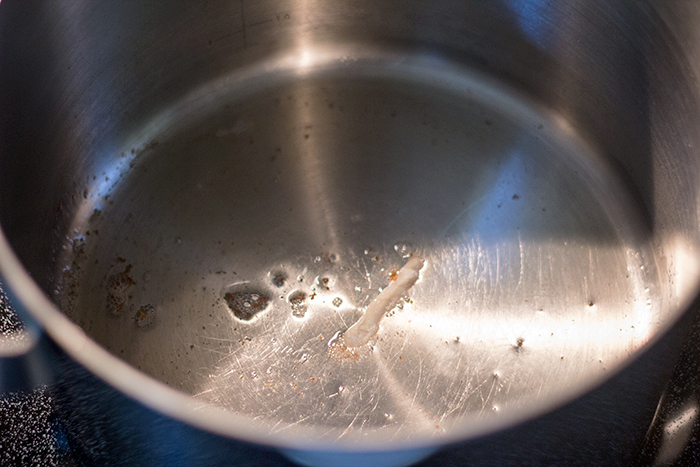
When it looks like this, it’s ready to sauté those thinly sliced onions.
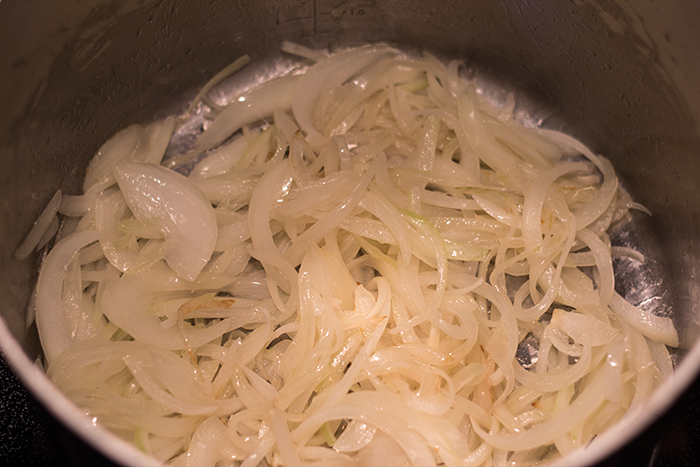
Once the onions turn translucent and start to brown, it’s ready for that jar of sauerkraut!
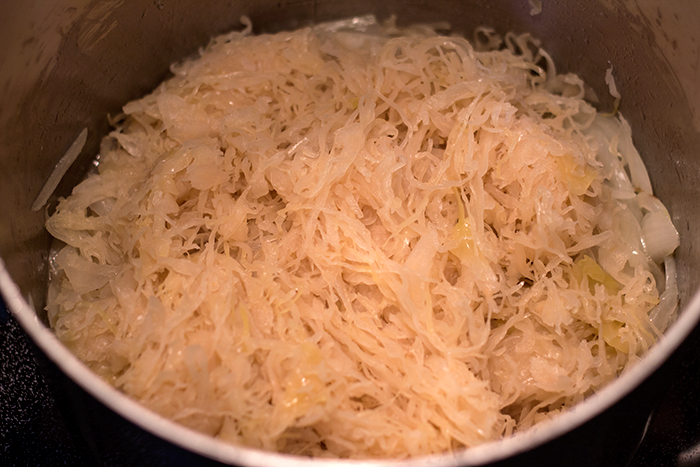
Dump in that jar of kraut and stir all up. Let it cook together for about 5 – 7 minutes.
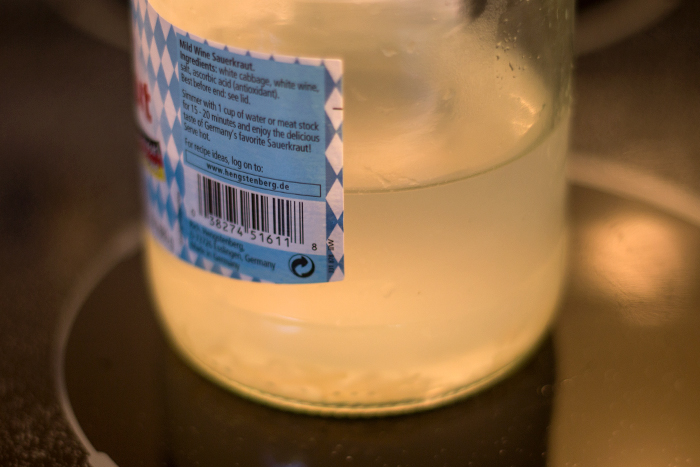
Next I add a little water to the sauerkraut so everything can cook nicely and steam the apples. I just use the empty jar for this and fill it up about half way because I like it to have some “juice”. Before I pour in the water, I swish it around in the jar to make sure it picks up any leftover pieces of sauerkraut. Heaven forbid we waste any of that kraut!
If you’re adding white wine to yours, this is when I’d add it. Leave out some of the water if you don’t want it to be too “juicy”.
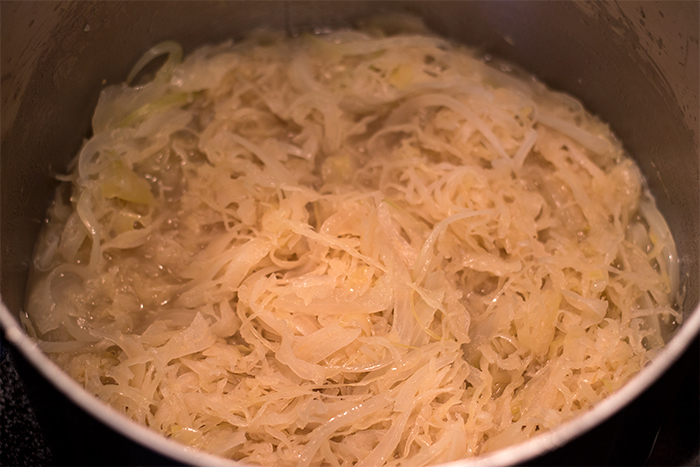
It’ll should look something like this.
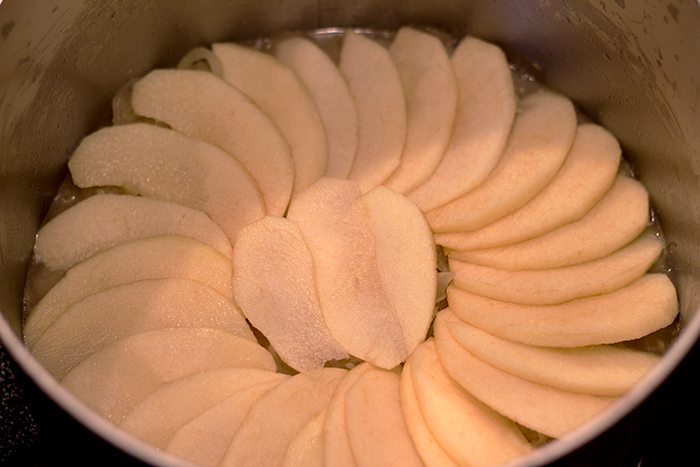
Lastly, we add those apple slices. Do you have to arrange them like this? No, of course not. It’s just something my Dad always does and I think it looks nice, so I follow suit. You just don’t want the apples to overlap too much.
Put the lid on the pot and let it simmer on a low heat for about 30 minutes. No stirring needed.
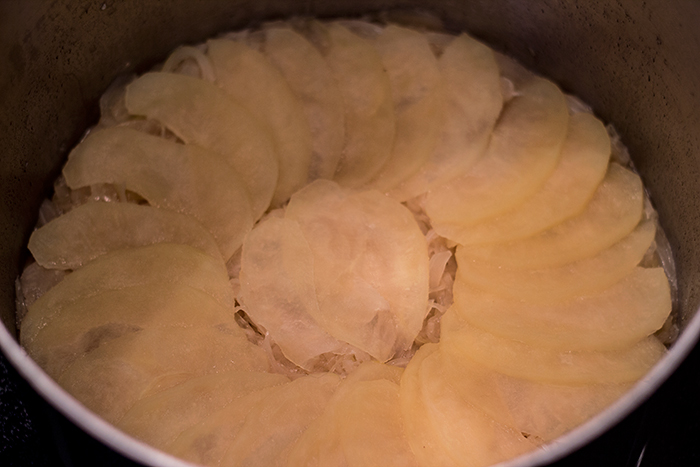
When it’s done, the apple slices will be fairly translucent. That’s it! If you’re just making the sauerkraut, stir it up and serve hot.
Though, if you’re going to eat it with some sausages, I’ll give you the info on how to best cook it with the sauerkraut I’m far less of a fan of the pork, so I’m not going to show that part in this post. Maybe I’ll explain that one day.
Anyway, let’s continue.

Just place the sausages on top of the sauerkraut. Here I’m using four German wieners (or frankfurters) and two knackwurst that I pick up at Liebchen Delicatessen. Close the lid and let it continue to cook for 15 minutes.
You could easily use any precooked type of sausage, like kielbasa, or yes, even hot dogs or Polish dogs. Don’t use something like bratwurst. They’re meant to be fried or grilled, not steamed, since they’re raw. I don’t think they’d cook all the way through.
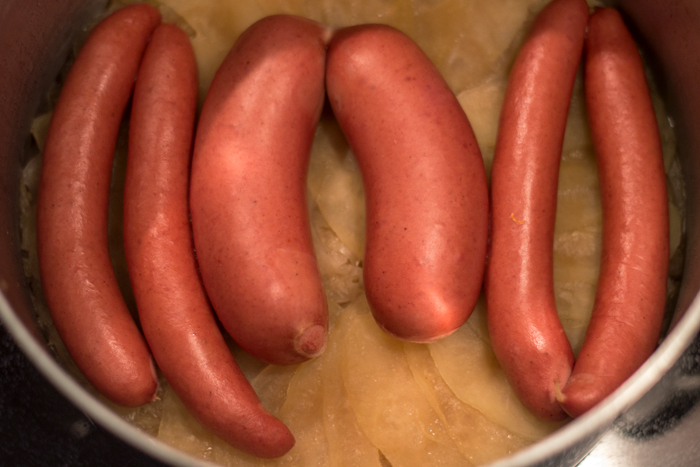
Oooh, yum. Bavarian style sauerkrait all done and ready to be devoured.

Serve it with a side of potatoes (mashed, roasted or boiled) and you have a little bit of German deliciousness on your plate!
Recap of Alternatives:
- You can use olive oil instead of bacon fat. Vegetable shortening would work too.
- You can add a cup of white wine if you end up using a jar that doesn’t already have wine. Add it with the water.
- If you’re making it with meat sausages, make sure they’re precooked.
Mahlzeit!
(If it matters to anyone, despite all the name dropping and linking I’m doing in this post, I’m not getting paid to do so.)

Bavarian Style Sauerkraut
Ingredients
- - One jar of sauerkraut We use Hengstenberg and it's 24oz or 1.5lbs
- - One medium to large yellow onion
- - One apple
- - About 1 tablespoon of bacon fat.
Instructions
-
Thinly slice the onions (vertically, halves or whole slices) and set aside. Peel, core and cut the apple into quarters. Slice thinly and set aside.
-
Melt a spoonful of bacon fat in a large pot on medium heat. Sauté the onions until translucent and are starting to brown. Add the sauerkraut, stir and let it cook for 5 - 7 mins.
-
Add half a jar of water. Place the apple slices on top of the sauerkraut. Arrange so that the flat side is down and there isn't too much overlap. Cover and let it simmer on a low heat setting for 30 minutes.
-
If you are adding meat sausages -
-
Once the sauerkraut is done, place the sausages on top and let them steam with the lid closed for 15 minutes.
-
Serve warm. Delicious with mashed potatoes.
Recipe Notes
- You can use olive oil instead of bacon fat. Vegetable shortening would work too.
- You can add a cup of white wine if you end up using a jar that doesn’t already have wine. Add it with the water.
- If you’re making it with meat sausages, make sure they’re precooked.
I really like Sauerkraut…and one is supposed to eat some fermented food daily…so when I open a can, I usually eat a bit raw and drink some of the juice. Also I like to add pork, the country ribs and brown them before we add the onions and the kraut…makes a great tasting kraut!
I always use kraut without wine, add a good amount of Riesling, some juniper berries, some clove and sometimes (streaky?) bacon at a stretch. Tastes wonderful. And the longer you cook it, the milder it gets.
I recently bought some juniper berries for when I want to make sauerbraten and have been wanting to try adding them to sauerkraut. With your recipe, how many do you add and when do you add them?
Sorry Diony, didn´t see you question.
l use just 5 juniper berries for one can of Sauerkraut (usually 850 g per can), squeeze them a bit with the flat side of a knife and add them right at the beginning.
And since l know they are in there l don´t make any effort to find and remove them at the end. Though biting on them is not recommended.
l always imagine the herbal character of those berries damp down the tartness (?) of the Kraut a bit.
Thanks for replying, Tanja! I’m totally trying this out the next time we make sauerkraut.
Canned sauerkraut is GOOD.
I do not “stay away” from it.
(BTW, even if you say it isn’t as
German as people think it is, nevertheless I am a “”kraut” myself, if you consider that even though
I am a native American from birth, all four of my grandparents were born in Germany.)
Obviously with a name like ‘Weiss’ I grew up with German Food!!! We all ate/eat Sauerkraut; but our favorite style of kraut was always Bavarian Style and ours ALWAYS used one table spoon of brown sugar to 32 ounces (two jars) of plain sauerkraut! The bacon drippings, the apples, the onions were fine, but the difference was the BROWN SUGAR…
Hi Karla!
Thanks so much for the comment. I bet the brown sugar makes your sauerkraut taste great! What we call brown sugar (sugar with molasses) isn’t sold in Germany. There is a brown sugar in Germany but it just means it’s raw sugar. Though, you can easily find some sauerkraut recipes that will call for a little bit of white sugar. It will definitely help tone down the tartness of sauerkraut even more.
I am Dutch , left Holland long time, was never sure how to cook Sauerkraut, today I discovered the Bavarian Kraut on Google and cooked it , lovely.brought memories back of my Mum’s sauerkraut. Will do int again soon, thank you ! I am going to try cooking ‘Boerenkool’ next. Any tips ? And oliebollen done that but should have been, ‘luchtigsr’.
Thanks
You’re welcome. Thank you so much for stopping by with your touching comment. To be told that my recipe brings back memories of your Mum’s cooking… that’s a big deal to me! Unfortunately, I don’t know enough about Dutch recipes to help you out with ‘Boerenkool’ (kale, right?). If you have that recipe for the oliebollen, I would love to try it out, though. I’m still working on getting the right texture for my homemade ‘doughnuts’ too. All the best.
I have been entranced by Bavarian Sauerkraut ever since my son and I ate a meal in Salzburg in the summer of 2014. Sausages, meat, boiled potatoes, and amazing sauerkraut were on the plate in this notable restaurant. I have eaten sauerkraut all my life and had one concept of what it was. This blew me away. It was soft like mashed potatoes, but still clearly sauerkraut. It was savory and tart and sweet all at the same time. Wow! I have had this on my mind for a long time. Your recipe comes very very close. I think that I made a mistake and dumped the sauerkraut and all the fluid that it was in into the pot. (I used a pouch from the deli rather than a jar. My proportions might have been a bit off.) Your recipe wasn’t clear on what to do with the fluid that the sauerkraut comes in. It now seems to me that I should have put the sauerkraut sans fluid into the pot to let it sauté. And perhaps if it had sauted a bit with the onion, it might have got softer. Then add the fluid that you describe after the sautéing process. What do you think? Anyway evern with the differences all in all it came out great. I can’t wait to try it again and make a few improvements. I want to try it with the wine. My wife did find a jar of “Bubbies” sauerkraut that seems to have a finer texture. It is from San Francisco. We live on the west coast, so we may have different companies producing sauerkraut here. I wonder if the softness of the sauerkraut is also how fine the cabbage is cut initially. I definitely am going to explore and try some different styles. We also have a Berlin style sauerkraut in a jar from a company called Kruegerman. I am going to stick with the jar types for a while.
Thanks so much for the wonderful comment, David. I really, truly appreciate the feedback.
You’re right, I don’t address what to do with the sauerkraut juice from the jar. I think I left that out because the Hengstenburg brand I use does not have a lot of juice. It’s mostly just kraut. I’ll have to think what the best way to address the fluids but I think you’re on the right track about leaving it off at first. Cooking it longer would be helpful in softening it up if it’s a thicker cut kraut. Definitely add the wine! It’s helps a lot in the flavour department as well. Stay with jars or cans will help (Hengstenberg makes a canned version called Mildessa). If you have a Cost Plus World Market close by, that’s a good place to look. It’s my go-to store for sauerkraut up here in Washington State.
Maybe I’ll go about making a comparison post using some different brands and/or types of sauerkraut found in the US with this recipe. That would give me a good way to experiment with the liquid in or out at first. I’m familiar with the Kruegermann’s brand for pickles and red cabbage but haven’t tried their sauerkraut. I’ll have to see if I can get some. I’d love to try it out!
I ferment my own Sauerkraut and was wondering what the difference between it an Bavarian. Thanks so much for the post! It looks like I’ll probably need to add some white wine to mine when I make this.
SJ
You’re very welcome. Fermenting my own sauerkraut is something I’ve always wanted to learn how to do, so I’m quite impressed. Yes, the addition of a cup of white wine to your homemade sauerkraut would help with this recipe! Would love to know how it turns out for you.
I will certainly let you know.
I bought a 5L Crock from Amazon, stuffed a few pounds of cabbage in it with copious amounts of salt. The salt breaks the Cabbage down and draws the water from it. Basically, set and leave for about six weeks. I’ve been putting a couple of TBS of Pepper Corns in it, but have decided it really doesn’t excite it very much. I”m anxious to throw your recipe at it.
Thanks again for the Recipe!
SJ
I had no idea that I could just order a fermenting crock on Amazon. Really should have known, though, as they sell everything. They even come with stone weights and free shipping. How great! When I start doing this myself (which now seems like it’ll happen soon), I’d like to experiment with using juniper berries and caraway seeds.
Thank you for cluing me into this and how easy it sounds to do it yourself!
Please let me know how it turns out! LOL
The crock works with a water seal. The water will draw in as the fermentation begins. It draws the water seal inside of the lid. Give it a wiggle and you’ll get a true result of how well it’s sealed, or if you need to add more. I use a brine mixture just in case it gets drawn into the crock.
SJ
I will do that. This is great information. Thank you so much!
You forgot the caraway seeds!!
I did! However, it was sort of on purpose. We just make it without all the time due to both my Dad and husband just hating them (so sad about this because I love caraway seeds) that I no longer think of it being part of the recipe. Plus, I have yet to meet an American that likes them.
Prove me wrong, Americans (or just non-Germans)! Chime in if you like caraways seeds.
So sorry, I only like the flavor of caraway seeds in very subtle amounts. I never grew up with seeds in my sauerkraut. My wife had dutch heritage and they have a cheese with caraway seeds called kamina kass!?! Many flavors, even like cilantro and others, are often too strong. To each his own.
I am enjoying this blog. We are planning to make our own sauerkraut as well.
Thank you. I’m so glad! Would love to know how your homemade sauerkraut turns out.
When I was in Berlin Germany, I went to the KaDaWe department store, top floor, to the food department. That place is a miracle in itself, you must see it to believe it.
One of the things I had there was the fantastically delicious sauerkraut with some sort of sausages. My knees get weak even thinking of the delicious flavor! I never knew how it was made. I happened to find your recipe and made it exactly as you did today, but also added white wine. I used the sauerkraut that I buy in the health food store which is freshly made, with caraway seeds! I happened to see a comment about adding brown sugar. After everything had cooked, I tasted it, then added some brown sugar….that was it!!!! That was the taste I remembered from the KaDaWe. HAPPY DAYS!!!
What do you mean Americans don’t like caraway seeds? I love them and use them in many recipes including cabbage slaws!
Thank you for the great recipe.
You’re very welcome, Penny. I’m so glad to hear that this recipe, plus the addition of brown sugar, is what you the taste you remembered!
I cook mine first by browning bacon, adding shredded potato and onion to the mix..then adding well-rinsed saurkraut, applesauce and chicken broth. I add some more apple slices in at the end, too.
Insult to injury–please explain the difference between Regular Sauerkraut vs. Bavarian Sauerkraut? Realize it specific spices.? I’ve gone tooth to nail w/grocery managers trying to attain a Bavarian Sauerkraut? Del Monte used to produce it. Thanks for any in-put you may give! We’re now arguing over fennel or sesame seeds per spices? I’m good for a case of Bavarian Sauerkraut, if it can be produced!
Thanks so much for your help!
Janet Webb
What makes jarred sauerkraut Bavarian style is that it’s not a salty and usually has the addition of white wine already added.
The rest of the additions I put in the sauerkraut is what further makes it Bavarian. Bavarian sauerkraut usually has bacon fat, apples, onions and sometimes spices like juniper berries or caraway seeds.
You do not need a jar of Bavarian style sauerkraut to make this recipe. Any would work, just need to rinse off the extra saltiness and add a half cup of semi sweet (or dry) white wine.
If you really want to jarred Bavarian style sauerkraut, look for Silver Floss, if you’re on the East Coast. You can all look for some at Aldi’s, which is another East Coast store. Alternatively, small German delis usually carry it (there’s a German Stores link in the menu above that might help you find one), as does World Market on the west coast. Lastly, you can order it online from Amazon.com or Germandeli.com, but I can’t speak to how expensive the shipping would be for a whole case.
I hope this helps.
I have found this sauerkraut brand at Big lots for $2.00 half the price of World Market
I use chicken broth bacon bits and the bacon grease and shredded carrots. Cook for a couple of hours on low, add shredded carrot and shredded potato.
That is how my mother taught me to make it. She was from Hof, Germany, and it tastes so good
our family loves caraway seed, even in rye bread, we are american, German and Irish desent.
I was wondering if I can make this with out cooking and just put it in a jar or crock as you woul when making kraut?